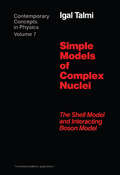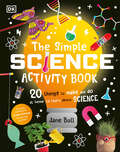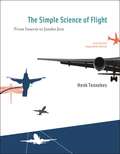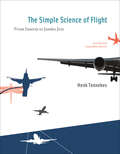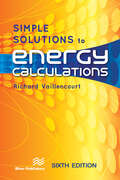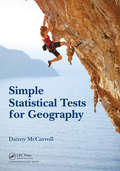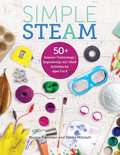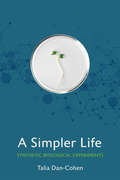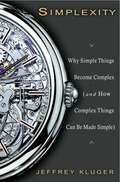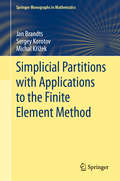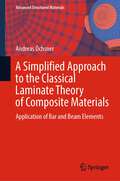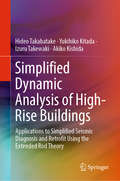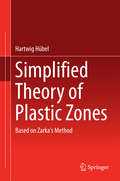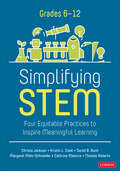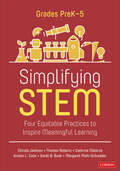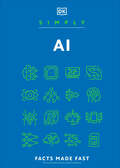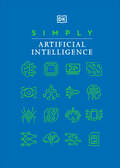- Table View
- List View
Simple Models of Complex Nuclei
by Igal Talmiapplications to the structure of atomic nuclei. The author systematically develops these models from the elementary level, through an introduction to tensor algebra, to the use of group theory in spectroscopy. The book's extensive and detailed appendix includes a large selection of useful formulae of tensor algebra and spectroscopy. The serious graduate student, as well as the professional physicist, will find this complete treatment of the shell model to be an invaluable addition to the literature.
The Simple Science Activity Book: 20 Things to Make and Do at Home to Learn About Science
by Jane BullLittle crafters will become little scientists as they explore, experiment, make, and create their way through every STEAM project.Learn through play with this hands-on crafty science book that introduces inquisitive children to the wonders of science through craft projects with everyday objects.The Simple Science Activity Book contains more than 20 fun-filled craft projects, each accompanied by a &‘What&’s the science?&’ section explaining how key scientific concepts work. Children can enjoy getting stuck in and learn how to make a toy raft and discover what makes their boat float, or how to create an ice sculpture and learn about the changing states of solids and liquids. They&’ll discover the world around them like they&’ve never seen it before!This hands-on science activity book for children offers: - Over 20 activities that are easy for children aged 5-7 to do on their own, with only a handful of steps requiring an adult to help.- A range of different projects, including art, photography, crafts, cooking, and gardening, all using everyday objects found in and around the home.- An introduction to key skills like problem-solving, observation, and hands-on learning through fun scientific experiments. With The Simple Science Activity Book, difficult concepts like buoyancy, gravity, and aerodynamics become meaningful and accessible to young children through play. Award-winning author Jane Bull combines art, craft, and cooking activities with solid scientific learning, showing children that science, technology, engineering, art, and maths are all around us – and in everything we make and do!
Simple Science Fun: Hands-on Science Made Easy
by Evan Forbes Janet Hale Cindy ChristiansonThe book introduces children to science with over 50 amazing, exciting, and intellectually stimulating activities.
The Simple Science of Flight: From Insects to Jumbo Jets (Revised and Expanded Edition)
by Henk TennekesFrom the smallest gnat to the largest aircraft, all things that fly obey the same aerodynamic principles. In The Simple Science of Flight, Henk Tennekes investigates just how machines and creatures fly: what size wings they need, how much energy is required for their journeys, how they cross deserts and oceans, how they take off, climb, and soar. Fascinated by the similarities between nature and technology, Tennekes offers an introduction to flight that teaches by association. Swans and Boeings differ in numerous ways, but they follow the same aerodynamic principles. Biological evolution and its technical counterpart exhibit exciting parallels. What makes some airplanes successful and others misfits? Why does the Boeing 747 endure but the Concorde now seem a fluke? Tennekes explains the science of flight through comparisons, examples, equations, and anecdotes. The new edition of this popular book has been thoroughly revised and much expanded. Highlights of the new material include a description of the incredible performance of bar-tailed godwits (7,000 miles nonstop from Alaska to New Zealand), an analysis of the convergence of modern jetliners (from both Boeing and Airbus), a discussion of the metabolization of energy featuring Lance Armstrong, a novel treatment of the aerodynamics of drag and trailing vortices, and an emphasis throughout on evolution, in nature and in engineering. Tennekes draws on new evidence on bird migration, new wind-tunnel studies, and data on new airliners. And his analysis of the relative efficiency of planes, trains, and automobiles is newly relevant. (On a cost-per-seat scale, a 747 is more efficient than a passenger car.)
The Simple Science of Flight, revised and expanded edition: From Insects to Jumbo Jets
by Henk TennekesAn investigation into how machines and living creatures fly, and of the similarities between butterflies and Boeings, paper airplanes and plovers.From the smallest gnat to the largest aircraft, all things that fly obey the same aerodynamic principles. In The Simple Science of Flight, Henk Tennekes investigates just how machines and creatures fly: what size wings they need, how much energy is required for their journeys, how they cross deserts and oceans, how they take off, climb, and soar. Fascinated by the similarities between nature and technology, Tennekes offers an introduction to flight that teaches by association. Swans and Boeings differ in numerous ways, but they follow the same aerodynamic principles. Biological evolution and its technical counterpart exhibit exciting parallels. What makes some airplanes successful and others misfits? Why does the Boeing 747 endure but the Concorde now seem a fluke? Tennekes explains the science of flight through comparisons, examples, equations, and anecdotes. The new edition of this popular book has been thoroughly revised and much expanded. Highlights of the new material include a description of the incredible performance of bar-tailed godwits (7,000 miles nonstop from Alaska to New Zealand), an analysis of the convergence of modern jetliners (from both Boeing and Airbus), a discussion of the metabolization of energy featuring Lance Armstrong, a novel treatment of the aerodynamics of drag and trailing vortices, and an emphasis throughout on evolution, in nature and in engineering. Tennekes draws on new evidence on bird migration, new wind-tunnel studies, and data on new airliners. And his analysis of the relative efficiency of planes, trains, and automobiles is newly relevant. (On a cost-per-seat scale, a 747 is more efficient than a passenger car.)
Simple Solutions Science Level 4 (Student Edition)
by Nancy L. Mcgraw Nancy Tondy Rebecca ToukonenA workbook that gives its readers the opportunity to revise the topics learn in previous grades and helps all readers develop a deeper and better understanding of scientific concepts in a scheduled lesson a day guide.
Simple Solutions to Energy Calculations
by Richard VaillencourtUpdated with new material, this book shares the author’s secrets for simplifying complex energy calculations, and shows you how to use these time-saving methods. It shows you how to cut through the maze using innovative decision-making tools to determine whether you should invest real time and money for developing details of a project being considered. There is information covered on simplified thermodynamics that gives you a blueprint for controlling the building’s energy consumption. Key topics covered include the walk-through audit, pumps & fans VFD, high efficiency motors, insulation, fuel switching, heat recovery, HVAC, air compressor, "energy myths and magic". Each chapter has "Richard’s Retrofit Rules" and anecdotal experience in the retrofit. There is a summary of energy calculations given by category, plus a discussion of performance guarantees that helps a building manager decide which ESCO can best deliver on their promises of energy savings.
Simple Statistical Tests for Geography
by Danny McCarrollThis book is aimed directly at students of geography, particularly those who lack confidence in manipulating numbers. The aim is not to teach the mathematics behind statistical tests, but to focus on the logic, so that students can choose the most appropriate tests, apply them in the most convenient way and make sense of the results. Introductory chapters explain how to use statistical methods and then the tests are arranged according to the type of data that they require. Diagrams are used to guide students toward the most appropriate tests. The focus is on nonparametric methods that make very few assumptions and are appropriate for the kinds of data that many students will collect. Parametric methods, including Student’s t-tests, correlation and regression are also covered. Although aimed directly at geography students at senior undergraduate and graduate level, this book provides an accessible introduction to a wide range of statistical methods and will be of value to students and researchers in allied disciplines including Earth and environmental science, and the social sciences.
Simple Steam: 50+ Science Technology Engineering Art and Math Activities for Ages 3 to 6
by Debby Mitchell Marnie ForestieriParents are eager to help their children learn, but teaching young children complicated scientific and mathematical concepts can be intimidating. Simple STEAM helps parents realize they don't need to be engineers or scientists to support STEAM learning. <P><P> <li>Help children explore STEAM concepts with fun and engaging activities <li>Discover STEAM learning opportunities in everyday activities and experiences <li>Prepare children for kindergarten <li>Build crucial 21st century learning skills, such as collaboration, communication, creativity and problem-solving, curiosity, and critical thinking
A Simpler Life: Synthetic Biological Experiments (Expertise: Cultures and Technologies of Knowledge)
by Talia Dan-CohenA Simpler Life approaches the developing field of synthetic biology by focusing on the experimental and institutional lives of practitioners in two labs at Princeton University. It highlights the distance between hyped technoscience and the more plodding and entrenched aspects of academic research. Talia Dan-Cohen follows practitioners as they wrestle with experiments, attempt to publish research findings, and navigate the ins and outs of academic careers. Dan-Cohen foregrounds the practices and rationalities of these pursuits that give both researchers' lives and synthetic life their distinctive contemporary forms. Rather than draw attention to avowed methodology, A Simpler Life investigates some of the more subtle and tectonic practices that bring knowledge, doubt, and technological intervention into new configurations. In so doing, the book sheds light on the more general conditions of contemporary academic technoscience.
A Simpler Way
by Margaret J. Wheatley Myron Kellner-RogersWe want life to be less arduous and more delightful. We want to be able to think differently about how to organize human activities. Our book springs from these desires. It explores a different way of thinking about life and about how organizing might occur. Our primary question is: How could we organize human endeavor if we developed different understandings of how life organizes itself? We ask this question for all of us, for there is no one who is unaffected by the organizations we humans have created.
Simplexity: Why Simple Things Become Complex (and How Complex Things Can Be Made Simple)
by Jeffrey KlugerWhy are the instruction manuals for cell phones incomprehensible? Why is a truck driver's job as hard as a CEO's? How can 10 percent of every medical dollar cure 90 percent of the world's disease? Why do bad teams win so many games?Complexity, as any scientist will tell you, is a slippery idea. Things that seem complicated can be astoundingly simple; things that seem simple can be dizzyingly complex. A houseplant may be more intricate than a manufacturing plant. A colony of garden ants may be more complicated than a community of people. A sentence may be richer than a book, a couplet more complicated than a song.These and other paradoxes are driving a whole new science--simplexity--that is redefining how we look at the world and using that new view to improve our lives in fields as diverse as economics, biology, cosmology, chemistry, psychology, politics, child development, the arts, and more. Seen through the lens of this surprising new science, the world becomes a delicate place filled with predictable patterns--patterns we often fail to see as we're time and again fooled by our instincts, by our fear, by the size of things, and even by their beauty.In Simplexity, Time senior writer Jeffrey Kluger shows how a drinking straw can save thousands of lives; how a million cars can be on the streets but just a few hundred of them can lead to gridlock; how investors behave like atoms; how arithmetic governs abstract art and physics drives jazz; why swatting a TV indeed makes it work better. As simplexity moves from the research lab into popular consciousness it will challenge our models for modern living. Jeffrey Kluger adeptly translates newly evolving theory into a delightful theory of everything that will have you rethinking the rules of business, family, art--your world.ve thousands of lives; how a million cars can be on the streets but just a few hundred of them can lead to gridlock; how investors behave like atoms; how arithmetic governs abstract art and physics drives jazz; why swatting a TV indeed makes it work better. As simplexity moves from the research lab into popular consciousness it will challenge our models for modern living. Jeffrey Kluger adeptly translates newly evolving theory into a delightful theory of everything that will have you rethinking the rules of business, family, art--your world.
Simplicial Partitions with Applications to the Finite Element Method (Springer Monographs in Mathematics)
by Jan Brandts Sergey Korotov Michal KřížekThis monograph focuses on the mathematical and numerical analysis of simplicial partitions and the finite element method. This active area of research has become an essential part of physics and engineering, for example in the study of problems involving heat conduction, linear elasticity, semiconductors, Maxwell's equations, Einstein's equations and magnetic and gravitational fields.These problems require the simulation of various phenomena and physical fields over complicated structures in three (and higher) dimensions. Since not all structures can be decomposed into simpler objects like d-dimensional rectangular blocks, simplicial partitions are important. In this book an emphasis is placed on angle conditions guaranteeing the convergence of the finite element method for elliptic PDEs with given boundary conditions. It is aimed at a general mathematical audience who is assumed to be familiar with only a few basic results from linear algebra, geometry, and mathematical and numerical analysis.
Simplicity of Complexity in Economic and Social Systems: Proceedings of the 54th Winter School of Theoretical Physics, Lądek Zdrój, Poland, February 18–24th 2018 (Springer Proceedings in Complexity)
by Dariusz Grech Janusz MiśkiewiczThis book presents the Proceedings of the 54th Winter School of Theoretical Physics on Simplicity of Complexity in Economic and Social Systems, held in Lądek Zdrój, Poland, from 18 to 24 February 2018. The purpose of the book is to introduce the new interdisciplinary research that links statistical physics, and particular attention is given to link physics of complex systems, with financial analysis and sociology. The main tools used in these areas are numerical simulation of agents behavior and the interpretation of results with the help of complexity methods, therefore a background in statistical physics and in physics of phase transition is necessary to take the first steps towards these research fields called econophysics and sociophysics. In this perspective, the book is intended to graduated students and young researchers who want to begin the study of this established new area, which connects physicists, economists, sociologists and IT professionals, to better understand complexity phenomena existing not only in physics but also in complex systems being seemingly far from traditional view at physics.
Simplified Analytical Methods of Elastic Plates
by Hideo TakabatakeThis book presents simplified analytical methodologies for static and dynamic problems concerning various elastic thin plates in the bending state and the potential effects of dead loads on static and dynamic behaviors. The plates considered vary in terms of the plane (e.g. rectangular or circular plane), stiffness of bending, transverse shear and mass. The representative examples include void slabs, plates stiffened with beams, stepped thickness plates, cellular plates and floating plates, in addition to normal plates. The closed-form approximate solutions are presented in connection with a groundbreaking methodology that can easily accommodate discontinuous variations in stiffness and mass with continuous function as for a distribution. The closed-form solutions can be used to determine the size of structural members in the preliminary design stages, and to predict potential problems with building slabs intended for human beings’ practical use.
A Simplified Approach to the Classical Laminate Theory of Composite Materials: Application of Bar and Beam Elements (Advanced Structured Materials #192)
by Andreas ÖchsnerThis book provides a systematic introduction to composite materials, which are obtained by a layer-wise stacking of one-dimensional bar/beam elements. Each layer may have different mechanical properties but each single layer is considered as isotropic. The major idea is to provide a simplified theory to easier understand the classical two-dimensional laminate theory for composites based on laminae with unidirectional fibers. In addition to the elastic behavior, failure is investigated based on the maximum stress, maximum strain, Tsai-Hill, and the Tsai-Wu criteria. Partial differential equations lay the foundation to mathematically describe the mechanical behavior of any classical structural member known in engineering mechanics, including composite materials. The so-called classical laminate theory provides a simplified stress analysis, and a subsequent failure analysis, without the solution of the system of coupled differential equations for the unknown displacements. The procedure provides the solution of a statically indeterminate system based on a generalized stress–strain relationship under consideration of the constitutive relationship and the definition of the so-called stress resultants. This laminate theory is typically provided for two-dimensional plane problems, where the basic structural element is a simple superposition of a classical plane elasticity element with a thin plate element under the consideration of an orthotropic constitutive law. This two-dimensional approach and the underlying advanced continuum mechanical modeling might be very challenging for some students, particularly at universities of applied sciences. Thus, a reduced approach, the so-called simplified classical laminate theory, has been developed. The idea is to use solely isotropic one-dimensional elements, i.e., a superposition of bar and beam elements, to introduce the major calculation steps of the classical laminate theory. Understanding this simplified theory is much easier and the final step it to highlight the differences when moving to the general two-dimensional case.
Simplified Dynamic Analysis of High-Rise Buildings: Applications to Simplified Seismic Diagnosis and Retrofit Using the Extended Rod Theory
by Akiko Kishida Izuru Takewaki Yukihiko Kitada Hideo TakabatakeThis book presents a simple analytical method based on the extended rod theory that allows the earthquake resistance of high-rise buildings to be easily and accurately evaluated at the preliminary design stage. It also includes practical software for applying the extended rod theory to the dynamic analysis of actual buildings and structures. High-rise buildings in large cities, built on soft ground consisting of sedimentary rock, tend to have low natural frequency. If ground motion due to an earthquake occurs at distant hypocenters, the vibration wave can be propagated through several sedimentary layers and act on skyscrapers as a long-period ground motion, potentially producing a resonance phenomenon that can cause severe damage. Accordingly, there is a pressing need to gauge the earthquake resistance of existing skyscrapers and to improve their seismic performance. This book was written by authors who have extensive experience in tall-building seismic design in Japan. The software included enables readers to perform dynamic calculations of skyscrapers’ resistance to vibrations. As such, it offers a valuable resource for practitioners and engineers, as well as students of civil engineering.
Simplified Theory of Plastic Zones
by Hartwig HübelThe present book provides a new method to estimate elastic plastic. It presents deformation via a seriesof a number of linear elastic analyses. For a life prediction ofstructures subjected to variable loads, frequently encountered in mechanicaland civil engineering, the cyclically accumulated deformation and the elasticplastic strain ranges are required. The Simplified Theory of Plastic Zones(STPZ) is a direct method which provides the estimates of these and all othermechanical quantities in the state of elastic and plastic shakedown. The STPZis described in detail, with emphasis on the fact that not only scientists butengineers working in applied fields and advanced students are able toget an idea of the possibilities and limitations of the STPZ. Numerousillustrations and examples are provided to support the reader's understanding.
Simplifying STEM [6-12]: Four Equitable Practices to Inspire Meaningful Learning (Corwin Mathematics Series)
by Sarah B. Bush Kristin L. Cook Margaret J. Mohr-Schroeder Christa Jackson Oliver Roberts Cathrine MaiorcaStart, focus, or extend your integrated STEM education journey with an authentic interdisciplinary perspective! In response to calls for active STEM learning that builds students’ agency and sense of belonging, teachers and leaders are being encouraged more and more to equitably implement integrated STEM instruction. This practical guidebook is designed to help educators create integrated STEM learning experiences that are inclusive for all students and allows them to experience STEM as scientists, innovators, mathematicians, creators, engineers, and technology experts! Addressing the STEM status quo and promoting inclusiveness in STEM fields, the authors center their work around the Equity-Oriented Conceptual Framework for STEM Literacy, which provides high-quality integrated strategies to connect students′ lived experiences to STEM learning. Simplifying STEM provides a ground-breaking model of the four Integrated STEM Practices (ISPs) to ensure coherent and aligned teaching across disciplines through authentic opportunities to meaningfully engage students. Learn how to simplify STEM with these four equitable practices to inspire deep learning Use critical and creative thinking to seek solutions Collaborate and use appropriate tools to engage in iterative design Communicate solutions based on evidence and data Recognize and use structures in real-world systems Including a STEM planning guide as well as instructional strategies and assessments for standard alignment, this is an essential resource for any educator seeking to empower their students with meaningful STEM learning experiences. The book includes an online implementation toolkit to give educators opportunities for powerful professional development built on collaboration and connection.
Simplifying STEM [6-12]: Four Equitable Practices to Inspire Meaningful Learning (Corwin Mathematics Series)
by Sarah B. Bush Kristin L. Cook Margaret J. Mohr-Schroeder Christa Jackson Oliver Roberts Cathrine MaiorcaStart, focus, or extend your integrated STEM education journey with an authentic interdisciplinary perspective! In response to calls for active STEM learning that builds students’ agency and sense of belonging, teachers and leaders are being encouraged more and more to equitably implement integrated STEM instruction. This practical guidebook is designed to help educators create integrated STEM learning experiences that are inclusive for all students and allows them to experience STEM as scientists, innovators, mathematicians, creators, engineers, and technology experts! Addressing the STEM status quo and promoting inclusiveness in STEM fields, the authors center their work around the Equity-Oriented Conceptual Framework for STEM Literacy, which provides high-quality integrated strategies to connect students′ lived experiences to STEM learning. Simplifying STEM provides a ground-breaking model of the four Integrated STEM Practices (ISPs) to ensure coherent and aligned teaching across disciplines through authentic opportunities to meaningfully engage students. Learn how to simplify STEM with these four equitable practices to inspire deep learning Use critical and creative thinking to seek solutions Collaborate and use appropriate tools to engage in iterative design Communicate solutions based on evidence and data Recognize and use structures in real-world systems Including a STEM planning guide as well as instructional strategies and assessments for standard alignment, this is an essential resource for any educator seeking to empower their students with meaningful STEM learning experiences. The book includes an online implementation toolkit to give educators opportunities for powerful professional development built on collaboration and connection.
Simplifying STEM [PreK-5]: Four Equitable Practices to Inspire Meaningful Learning (Corwin Mathematics Series)
by Sarah B. Bush Kristin L. Cook Margaret J. Mohr-Schroeder Christa Jackson Oliver Roberts Cathrine MaiorcaStart, focus, or extend your integrated STEM education journey with an authentic interdisciplinary perspective! In response to calls for active STEM learning that builds students’ agency and sense of belonging, teachers and leaders are being encouraged more and more to equitably implement integrated STEM instruction. This practical guidebook is designed to help educators create integrated STEM learning experiences that are inclusive for all students and allows them to experience STEM as scientists, innovators, mathematicians, creators, engineers, and technology experts! Addressing the STEM status quo and promoting inclusiveness in STEM fields, the authors center their work around the Equity-Oriented Conceptual Framework for STEM Literacy, which provides high-quality integrated strategies to connect students′ lived experiences to STEM learning. Simplifying STEM provides a ground-breaking model of the four Integrated STEM Practices (ISPs) to ensure coherent and aligned teaching across disciplines through authentic opportunities to meaningfully engage students. Learn how to simplify STEM with these four equitable practices to inspire deep learning Use critical and creative thinking to seek solutions Collaborate and use appropriate tools to engage in iterative design Communicate solutions based on evidence and data Recognize and use structures in real-world systems Including a STEM planning guide as well as instructional strategies and assessments for standard alignment, this is an essential resource for any educator seeking to empower their students with meaningful STEM learning experiences. The book includes an online implementation toolkit to give educators opportunities for powerful professional development built on collaboration and connection.
Simplifying STEM [PreK-5]: Four Equitable Practices to Inspire Meaningful Learning (Corwin Mathematics Series)
by Sarah B. Bush Kristin L. Cook Margaret J. Mohr-Schroeder Christa Jackson Oliver Roberts Cathrine MaiorcaStart, focus, or extend your integrated STEM education journey with an authentic interdisciplinary perspective! In response to calls for active STEM learning that builds students’ agency and sense of belonging, teachers and leaders are being encouraged more and more to equitably implement integrated STEM instruction. This practical guidebook is designed to help educators create integrated STEM learning experiences that are inclusive for all students and allows them to experience STEM as scientists, innovators, mathematicians, creators, engineers, and technology experts! Addressing the STEM status quo and promoting inclusiveness in STEM fields, the authors center their work around the Equity-Oriented Conceptual Framework for STEM Literacy, which provides high-quality integrated strategies to connect students′ lived experiences to STEM learning. Simplifying STEM provides a ground-breaking model of the four Integrated STEM Practices (ISPs) to ensure coherent and aligned teaching across disciplines through authentic opportunities to meaningfully engage students. Learn how to simplify STEM with these four equitable practices to inspire deep learning Use critical and creative thinking to seek solutions Collaborate and use appropriate tools to engage in iterative design Communicate solutions based on evidence and data Recognize and use structures in real-world systems Including a STEM planning guide as well as instructional strategies and assessments for standard alignment, this is an essential resource for any educator seeking to empower their students with meaningful STEM learning experiences. The book includes an online implementation toolkit to give educators opportunities for powerful professional development built on collaboration and connection.
Simply AI (DK Simply)
by DKUnderstanding AI has never been easier.Combining bold graphics with easy-to-understand text, Simply Artificial Intelligence is the perfect introduction to the world of AI for those who are short of time but hungry for knowledge.Covering a broad range of fields within AI – from computing and mathematics to politics and philosophy – entries demystify what artificial intelligence is and how it works, how it has dramatically changed the way we live, and how it might evolve in the future.Explaining each individual aspect of AI more clearly than ever before, the book outlines the key building-blocks and technological milestones in its history, profiles its most important practical applications – both currentand predicted – and explores the numerous ethical debates around AI, and its increasing influence on culture and society.Whether you are studying science or AI-related subjects at school or college, or simply want a jargon-free overview of this increasingly important subject, this essential guide is packed with everything you need to understand the basics quickly and easily.
Simply Artificial Intelligence (DK Simply)
by DKUnderstanding AI has never been easier with Simply Artificial Intelligence. Combining bold graphics with easy-to-understand text, Simply Artificial Intelligence is the perfect introduction to the world of AI for those who are short of time but hungry for knowledge.Covering a broad range of fields within AI – from computing and mathematics to politics and philosophy – entries demystify what artificial intelligence is and how it works, how it has dramatically changed the way we live, and how it might evolve in the future.Explaining each individual aspect of AI more clearly than ever before, the book outlines the key building-blocks and technological milestones in its history, profiles its most important practical applications – both current and predicted – and explores the numerous ethical debates around AI, and its increasing influence on culture and society. Dive deep into this book to further discover: - Clear graphics and simple definitions make this complex and increasingly important subject easier to grasp than ever before.- Entries cover a broad range of relevant subject areas – from computing and mathematics to philosophy and politics – exploring and explaining each one in a super-simple way.-Easy-to-understand graphics help to explain over 120 concepts, applications, and theories in a clear, visual way.Whether you are studying science or AI-related subjects at school or college, or simply want a jargon-free overview of this increasingly important subject, this essential guide is packed with everything you need to understand the basics quickly and easily. Perfect for complete beginners and time-poor readers looking for a quick overview of AI.At DK, we believe in the power of discovery. So why stop there? If you like Simply AI then why not complete the collection and try the other books in DK&’s wonderful Simply series? Explore the inner workings of the brain like never before with Simply Brain, start asking deeper questions with Simply Philosophy or soar into space with Simply Astronomy.
